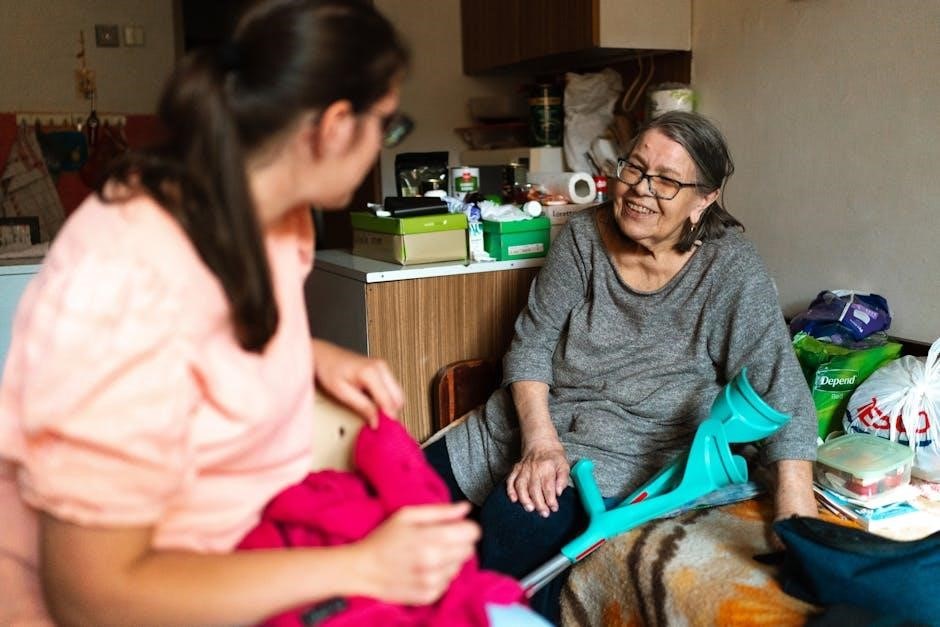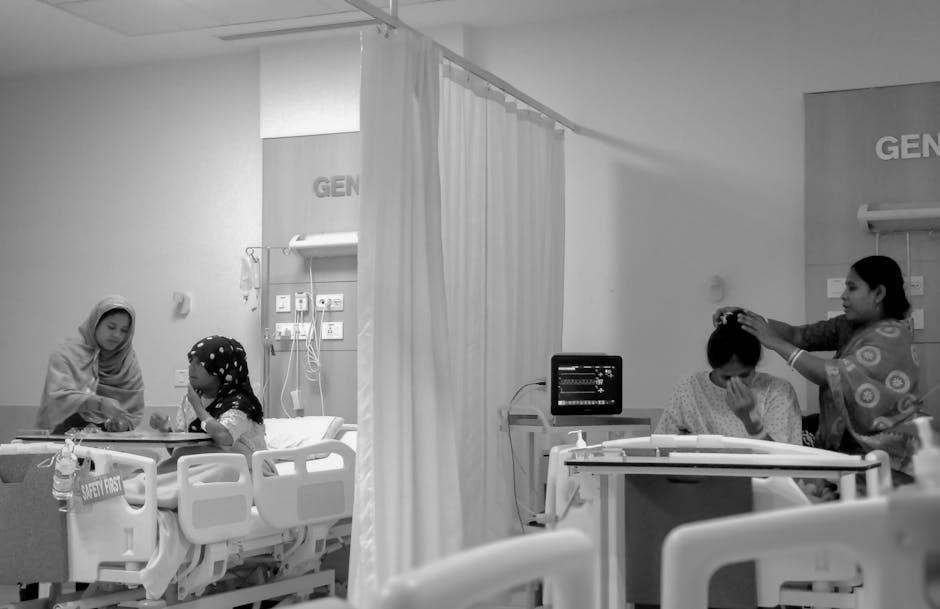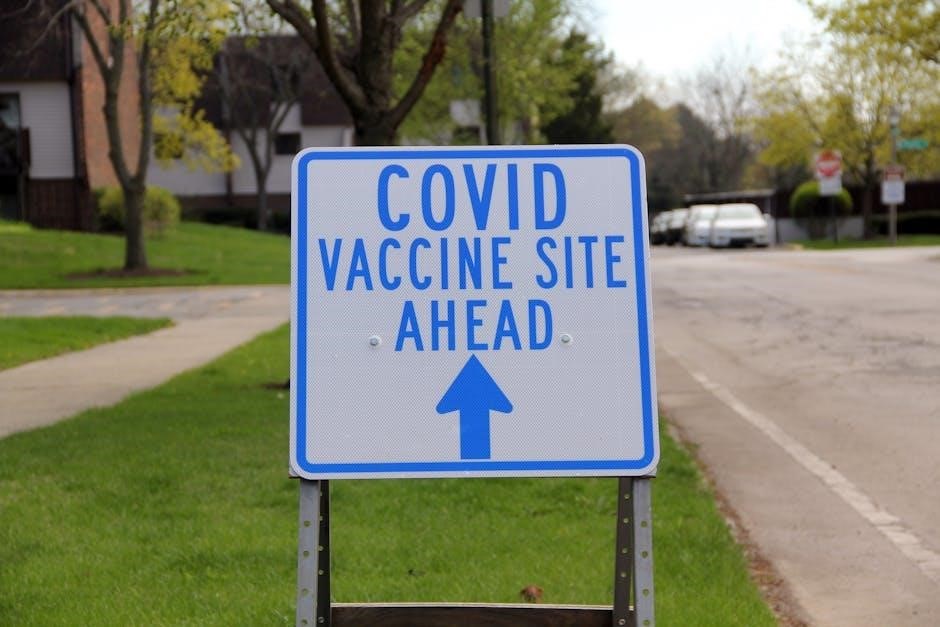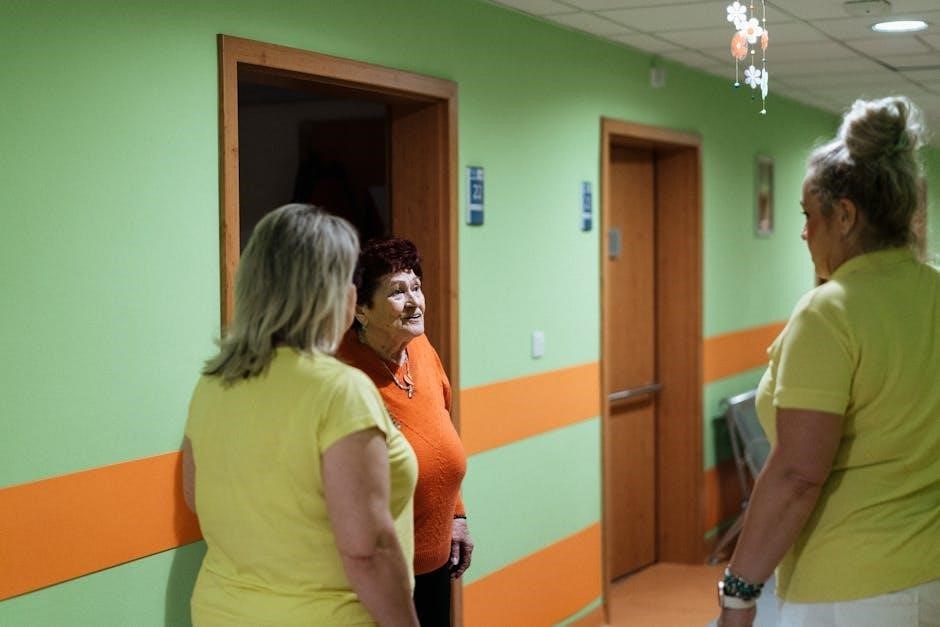Community and Public Health Nursing, 10th Edition, provides an engaging introduction to population-focused care, emphasizing visual learning and practical skills for promoting health and preventing diseases.
Definition and Scope of Community and Public Health Nursing
Community and Public Health Nursing focuses on promoting health and preventing diseases at the population level. It involves addressing the health needs of diverse communities, emphasizing prevention, intervention, and empowerment. The 10th edition highlights the scope of public health nursing, which includes protecting vulnerable populations, addressing social determinants of health, and advocating for health equity. This approach requires a population-based perspective, equipping nurses with the skills to address community health challenges effectively and foster healthier outcomes across various settings.
Importance of Population-Focused Care in Public Health
Population-focused care is essential in public health, as it targets health interventions at the community level. This approach ensures that strategies are tailored to the specific needs of populations, improving health outcomes and reducing disparities. By addressing social determinants and promoting preventive measures, nurses can address health issues before they escalate. The 10th edition emphasizes this method, highlighting its effectiveness in fostering healthier communities and ensuring equitable access to care for all individuals, regardless of their background or circumstances.
Overview of the 10th Edition of the Textbook
The 10th edition of Community and Public Health Nursing offers a comprehensive, visually engaging guide to public health nursing. It introduces population-focused care, emphasizing prevention, health promotion, and protection of at-risk populations. Updated content addresses emerging issues like infectious diseases and disaster preparedness. The edition includes practical tools, case studies, and evidence-based practices, making it a valuable resource for students and practitioners alike. Its student-friendly approach ensures readability and applicability in real-world settings, preparing nurses to address contemporary public health challenges effectively.

Key Concepts in Community and Public Health Nursing
Key concepts include population-based care, social determinants of health, health promotion, and protecting vulnerable populations, all aimed at improving community health outcomes through evidence-based strategies.
Population-Based Approach to Health Care
A population-based approach focuses on addressing health needs across entire communities rather than individuals. This method emphasizes preventive care, disease surveillance, and health promotion, ensuring resources are allocated effectively to reduce health disparities. The 10th edition highlights how nurses use data and community assessments to design interventions that target specific populations, improving overall public health outcomes and equity. This approach is central to modern public health nursing, enabling nurses to address the unique needs of diverse groups and promote healthier communities.
Social Determinants of Health
Social determinants of health, such as poverty, housing instability, education, and access to healthcare, significantly influence community well-being. The 10th edition emphasizes how these factors shape health outcomes and equity. Public health nurses play a critical role in addressing these determinants by advocating for policies and interventions that reduce disparities. By understanding and tackling these root causes, nurses can help create healthier environments and improve population health, ensuring equitable opportunities for all individuals to thrive.
Health Promotion and Disease Prevention Strategies
The 10th edition highlights evidence-based strategies for health promotion and disease prevention, focusing on education, vaccination, and community engagement. Nurses play a vital role in implementing these strategies, emphasizing early interventions and lifestyle modifications. By addressing risk factors and fostering healthy behaviors, public health nurses empower communities to reduce chronic diseases and improve overall well-being. These approaches are tailored to meet the unique needs of diverse populations, ensuring equitable access to preventive care and promoting long-term health outcomes.
Protecting Vulnerable and At-Risk Populations
The 10th edition emphasizes the critical role of public health nurses in safeguarding vulnerable populations, such as older adults, children, and those experiencing socioeconomic disparities. Strategies include targeted education, access to care, and advocacy to address systemic barriers. Nurses work to identify risks early and implement interventions that promote safety and well-being. By prioritizing these groups, public health nursing ensures equitable health outcomes and fosters resilience within communities. This approach underscores the importance of tailored care to meet the unique needs of at-risk populations.

The Role of Public Health Nurses
Public health nurses play a crucial role in promoting health, preventing diseases, and protecting at-risk populations through population-focused care and advocacy for community well-being.
Responsibilities of Public Health Nurses
Public health nurses are responsible for promoting health, preventing diseases, and protecting populations through education, outreach, and advocacy. They assess community needs, develop interventions, and collaborate with interdisciplinary teams to address health disparities. Key responsibilities include implementing population-focused care strategies, conducting health screenings, and providing health education. They also work to identify and mitigate risks, such as infectious diseases and environmental hazards. By addressing social determinants of health, public health nurses play a vital role in improving community well-being and equity. Their work spans diverse settings, from clinics to disaster response scenarios.
Skills and Competencies Required for Public Health Nursing
Public health nurses must possess a blend of clinical expertise and community engagement skills. They need strong communication abilities to educate diverse populations and advocate for health equity. Critical thinking and problem-solving are essential for addressing complex health issues. Nurses should be proficient in data collection and analysis to inform evidence-based practices. Cultural competence and empathy are crucial for working with vulnerable populations. Additionally, they must stay updated on public health trends and policies, demonstrating adaptability in dynamic community settings. These skills enable effective collaboration with interdisciplinary teams to improve population health outcomes.
Collaboration with Interdisciplinary Teams
Effective collaboration with interdisciplinary teams is vital in public health nursing. Nurses work alongside healthcare providers, social workers, policymakers, and community leaders to address health disparities. Strong communication and mutual respect foster cohesive strategies. By sharing expertise, teams can develop comprehensive interventions tailored to population needs. This collaborative approach ensures holistic care, addressing not only medical issues but also social determinants of health. It enhances resource allocation and improves health outcomes, making it a cornerstone of successful public health initiatives. Such teamwork is emphasized in the 10th edition as a key strategy for advancing community well-being.

Historical Development of Public Health Nursing
This section explores the origins and evolution of public health nursing, highlighting key milestones and its integration into modern healthcare systems over time.
Evolution of Public Health Nursing Practices
Public health nursing has evolved significantly, shifting from individual-focused care to population-based strategies. The 10th edition highlights how practices have adapted to emerging health challenges, integrating new technologies and evidence-based interventions. Historical milestones, such as responses to infectious diseases and disaster preparedness, demonstrate the field’s growth. Modern approaches emphasize prevention, health promotion, and addressing social determinants. This evolution underscores the dynamic nature of public health nursing in addressing contemporary and future health needs effectively.
Key Milestones in the History of Public Health
Historical milestones in public health include the establishment of sanitation systems, vaccination campaigns, and advancements in disease control. The 10th edition highlights these achievements, showcasing how they laid the foundation for modern public health nursing. Key events include the eradication of smallpox, the rise of health education, and responses to pandemics. These milestones reflect the evolution of public health from reactive measures to proactive, population-focused strategies, underscoring the critical role of nurses in promoting community well-being and preventing disease.
Influence of Public Health Movements on Nursing Practice
Public health movements have significantly shaped nursing practice by emphasizing prevention, education, and community care. The 10th edition explores how these movements shifted nursing from hospital-centric care to population-focused interventions. Nurses now play pivotal roles in health promotion, disease prevention, and advocating for health equity. These shifts have equipped nurses with tools to address social determinants of health, fostering a holistic approach to patient care and community well-being. This evolution is central to modern public health nursing, as highlighted in the 10th edition.

Community and Public Health Nursing in the 10th Edition
The 10th edition emphasizes population-focused care, updated tools, and interventions, addressing modern public health challenges. It equips nurses with skills to promote health across diverse settings effectively.
What’s New in the 10th Edition?
The 10th edition introduces updated content on emerging public health issues, enhanced visual elements for better learning, and expanded coverage of social determinants of health. It includes new case studies addressing infectious diseases and disaster preparedness, providing practical insights for nurses. The edition also emphasizes evidence-based practice and cultural competence, ensuring students are well-prepared to address modern health challenges in diverse settings. These updates reflect the dynamic nature of public health nursing, equipping future nurses with essential skills and knowledge.
Key Features of the 10th Edition
The 10th edition offers a highly visual, student-friendly format with updated content on emerging public health issues. It includes enhanced case studies, practical applications, and evidence-based practice examples. The edition emphasizes a population-based approach, addressing social determinants of health and vulnerable populations. New tools and resources support critical thinking and cultural competence, preparing students to address modern health challenges. The textbook also provides access to online platforms for interactive learning, making it a comprehensive resource for understanding community and public health nursing.
Relevance of Population-Focused Tools in Modern Nursing
Population-focused tools in the 10th edition are essential for addressing modern health challenges, enabling nurses to assess community needs and implement targeted interventions. These tools emphasize evidence-based practice, cultural competence, and collaboration, ensuring care is tailored to diverse populations. By integrating these tools, nurses can effectively address health disparities, promote wellness, and manage chronic conditions, making them indispensable in today’s dynamic healthcare landscape.

Public Health Issues and Challenges
Public health issues include infectious diseases, disaster response, and healthcare policies, requiring nurses to address diverse challenges while protecting vulnerable populations and promoting community well-being effectively.
Addressing Infectious Diseases in Community Settings
Community and Public Health Nursing, 10th Edition, emphasizes the critical role of public health nurses in preventing and managing infectious diseases. Nurses employ population-based approaches to identify high-risk groups and implement targeted interventions. The text highlights strategies such as vaccination campaigns, health education, and disease surveillance to control outbreaks. It also addresses emerging challenges like antibiotic resistance and global health threats. By focusing on community-wide prevention and education, nurses play a vital role in reducing the spread of infectious diseases and protecting vulnerable populations, aligning with the 10th edition’s emphasis on evidence-based practice and disaster preparedness.
Role of Nurses in Disaster Preparedness and Response
Community and Public Health Nursing, 10th Edition, highlights the crucial role of nurses in disaster preparedness and response. Nurses are essential in developing emergency plans, educating communities, and coordinating with interdisciplinary teams. During disasters, they provide triage, care, and emotional support, ensuring vulnerable populations receive attention. Post-disaster, nurses focus on recovery efforts and health surveillance. The text underscores their adaptability and leadership in crises, emphasizing the importance of preparedness to protect public health and safety in emergency situations, aligning with the edition’s focus on population-based care and disaster response strategies.
Impact of Healthcare Policies on Public Health
Healthcare policies significantly influence public health outcomes, shaping access to care, health equity, and disease prevention strategies. Community and Public Health Nursing, 10th Edition, explores how policies affect individuals, families, and populations, emphasizing their role in promoting or hindering health. Nurses play a critical role in advocating for policies that address social determinants of health and ensure equitable care. The text highlights the importance of understanding and navigating policy changes to improve population health and advocate for evidence-based practices that align with public health goals, particularly in vulnerable communities.

Application of Public Health Principles
Community and Public Health Nursing, 10th Edition, emphasizes the application of evidence-based strategies and population-focused tools to address health issues, promoting prevention and equity to enhance community well-being.
Community Health Assessment and Intervention
Community Health Assessment and Intervention focuses on evaluating population health needs and implementing strategies to address them. The 10th edition highlights evidence-based practices for conducting assessments and designing interventions that promote health equity and disease prevention. Nurses learn to collaborate with communities, analyze data, and develop targeted programs to improve health outcomes. This section emphasizes the importance of cultural competence and community engagement in creating effective interventions tailored to specific populations and settings, ensuring sustainable and impactful results.
Evidence-Based Practice in Public Health Nursing
Community and Public Health Nursing, 10th Edition, emphasizes the role of evidence-based practice in improving population health outcomes. This approach integrates the best available research, clinical expertise, and patient preferences to guide decision-making. The textbook highlights how public health nurses can apply evidence-based strategies to design interventions, evaluate programs, and advocate for policies that promote health equity. By fostering critical thinking and staying updated on current research, nurses can deliver high-quality, effective care that addresses the unique needs of diverse populations and settings.
Case Studies in Public Health Nursing
Community and Public Health Nursing, 10th Edition, incorporates real-world case studies to illustrate effective strategies for addressing public health challenges. These case studies explore scenarios such as infectious disease outbreaks, disaster response, and care for vulnerable populations. By analyzing these examples, students can develop critical thinking skills and learn how to apply evidence-based practices in diverse community settings. The case studies also highlight the importance of collaboration, cultural competence, and health equity in delivering impactful care. They serve as valuable tools for preparing future nurses to navigate complex public health situations.

Learning Resources and Tools
Community and Public Health Nursing, 10th Edition, offers test banks, study materials, and online platforms to enhance learning. These tools support exam preparation and interactive engagement.
Test Banks and Study Materials for the 10th Edition
Community and Public Health Nursing, 10th Edition, provides comprehensive test banks and study materials to support student learning. These resources include practice questions, case studies, and interactive tools designed to reinforce key concepts. The test banks are carefully edited and tested to ensure accuracy and relevance, helping students prepare for exams and apply theoretical knowledge in real-world scenarios; Accessible in PDF format, these materials are ideal for self-study and classroom use, promoting critical thinking and evidence-based practice in public health nursing.
Online Platforms for Accessing the 10th Edition
Community and Public Health Nursing, 10th Edition, is accessible through various online platforms, including Google Play Books and Docsity. These platforms offer easy access to the eBook, enabling students to download, highlight, and bookmark content for offline reading. Additionally, Flip PDF Plus Pro and other digital libraries provide interactive features, such as search functions and zoom capabilities, enhancing the learning experience. This accessibility ensures that nursing students can engage with the material anytime, anywhere, using PCs, Android, or iOS devices.
Engaging Learning Strategies for Nursing Students
Community and Public Health Nursing, 10th Edition, employs engaging learning strategies to cater to diverse learning styles. The textbook incorporates visual aids like graphs and infographics to simplify complex concepts. Interactive tools, such as test banks and study materials, enhance critical thinking and problem-solving skills. Real-life case studies and evidence-based practice examples provide practical insights, preparing students for real-world challenges. The eBook format allows for easy navigation, highlighting, and note-taking, making it an ideal resource for active learners. These strategies foster a deeper understanding of population-focused care and cultural competence.

Ethical Considerations in Public Health Nursing
Community and Public Health Nursing, 10th Edition, emphasizes ethical principles like privacy, confidentiality, and respect for diversity. It highlights the importance of cultural competence in care delivery.
Ethical Dilemmas in Population-Focused Care
Ethical dilemmas in population-focused care arise when balancing individual rights with collective health goals; The 10th edition explores challenges like privacy vs. public health needs, resource allocation, and cultural sensitivity. Nurses must navigate these issues while respecting diverse values and ensuring equitable care. The textbook provides case studies and frameworks to address such dilemmas, promoting ethical decision-making in complex scenarios. These tools help nurses uphold professionalism and justice in their practice, ensuring ethical standards are maintained in community settings.
Respecting Diversity and Cultural Competence
Respecting diversity and cultural competence are crucial in public health nursing, as they ensure inclusive care for all populations. The 10th edition emphasizes understanding cultural differences, values, and beliefs to provide tailored interventions. Nurses are encouraged to assess cultural influences on health behaviors and adapt care strategies accordingly. This approach fosters trust and improves health outcomes in diverse communities. The textbook offers practical tools and case studies to enhance nurses’ cultural awareness, ensuring equitable and person-centered care across varying cultural contexts.
Privacy and Confidentiality in Public Health Practice
Privacy and confidentiality are fundamental ethical principles in public health nursing. The 10th edition highlights the importance of safeguarding patient information, particularly in community settings where data collection and sharing are common. Nurses must adhere to legal standards like HIPAA to protect sensitive health information. Breaches can erode trust, making it harder to engage communities in health initiatives. The textbook provides strategies for maintaining confidentiality while addressing public health concerns, ensuring ethical practice without compromising individual privacy rights.

Future Trends in Community and Public Health Nursing
Future trends in public health nursing include leveraging emerging technologies and addressing global health challenges. Nurses will play a crucial role in advocating for health equity and innovation.
Emerging Technologies in Public Health Nursing
Emerging technologies are transforming public health nursing, enhancing care delivery and population health management. Telehealth platforms enable remote patient monitoring, while data analytics and AI predict health trends. Mobile apps and wearable devices promote health education and disease prevention. The Internet of Things (IoT) improves real-time data collection, and electronic health records (EHRs) enhance care coordination. These innovations empower nurses to address health disparities and deliver personalized interventions, ensuring equitable access to care for diverse populations.
Global Health Challenges and Nursing Responses
Global health challenges, such as pandemics, infectious diseases, and climate-related disasters, demand innovative nursing responses. Public health nurses play a critical role in addressing these issues by promoting health education, implementing vaccination programs, and supporting vulnerable populations. Collaboration with global organizations like the WHO enhances disaster preparedness and response. Nurses also advocate for health equity, ensuring access to care for underserved communities. By leveraging evidence-based practices and cultural competence, public health nurses contribute to building resilient health systems worldwide.
Advocacy for Health Equity in the Future
Advocating for health equity is a cornerstone of public health nursing. Nurses must champion policies and programs that address systemic inequalities, ensuring equitable access to care for marginalized populations. By leveraging population-focused tools and collaborating with interdisciplinary teams, nurses can drive meaningful change. Future efforts will emphasize cultural competence, community empowerment, and innovative strategies to reduce health disparities. Proactive advocacy ensures that all individuals, regardless of background, can achieve optimal health outcomes, fostering a more just and equitable healthcare system globally.

Be First to Comment